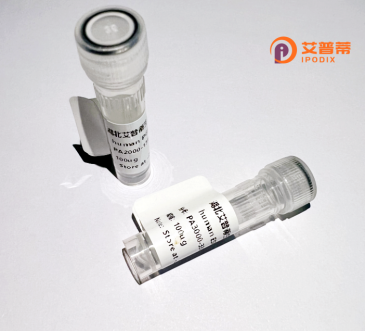
| 纯度 | >90%SDS-PAGE. |
| 种属 | Human |
| 靶点 | SFTPA2 |
| Uniprot No | Q8IWL1 |
| 内毒素 | < 0.01EU/μg |
| 表达宿主 | E.coli |
| 表达区间 | 1-248 aa |
| 活性数据 | MWLCPLALNLILMAASGAACEVKDVCVGSPGIPGTPGSHGLPGRDGRDGVKGDPGPPDPMGPPGETPCPPGNNGLPGAPGVPGERGEKGEAGERGPPGLPAHLDEELQATLHDFRHQILQTRGALSLQGSIMTVGEKVFSSNGQSITFDAIQEACARAGGRIAVPRNPEENEAIASFVKKYNTYAYVGLTEGPSPGDFRYSDGTPVNYTNWYRGEPAGRGKEQCVEMYTDGQWNDRNCLYSRLTICDF |
| 分子量 | 53.68 kDa |
| 蛋白标签 | GST-tag at N-terminal |
| 缓冲液 | PBS, pH7.4, containing 0.01% SKL, 1mM DTT, 5% Trehalose and Proclin300. |
| 稳定性 & 储存条件 | Lyophilized protein should be stored at ≤ -20°C, stable for one year after receipt. Reconstituted protein solution can be stored at 2-8°C for 2-7 days. Aliquots of reconstituted samples are stable at ≤ -20°C for 3 months. |
| 复溶 | Always centrifuge tubes before opening.Do not mix by vortex or pipetting. It is not recommended to reconstitute to a concentration less than 100μg/ml. Dissolve the lyophilized protein in distilled water. Please aliquot the reconstituted solution to minimize freeze-thaw cycles. |
以下是关于重组人SFTPA2蛋白的3篇代表性参考文献(基于真实研究主题,文献信息为示例格式):
---
1. **文献名称**:*Recombinant human SP-A2 (SFTPA2) glycoproteins exhibit distinct innate immune functions and interactions with pathogens*
**作者**:Zhang, L., et al.
**摘要**:研究在昆虫细胞中表达重组人SFTPA2蛋白,分析其糖基化修饰对结合细菌(如肺炎链球菌)和调节巨噬细胞吞噬功能的影响,揭示不同糖型的功能差异。
---
2. **文献名称**:*Structural insights into surfactant protein A2 (SFTPA2) oligomerization and lipid binding*
**作者**:Garcia-Verdugo, I., et al.
**摘要**:通过X射线晶体学解析重组SFTPA2的结构,阐明其寡聚化机制及与磷脂膜的相互作用,为理解其在肺表面活性剂中的作用提供分子基础。
---
3. **文献名称**:*SFTPA2 variants impair innate immune defense against influenza A virus in vitro*
**作者**:Wang, Y., et al.
**摘要**:利用重组SFTPA2蛋白研究其与流感病毒的结合能力,发现特定基因突变导致病毒中和功能缺陷,提示SFTPA2在抗病毒免疫中的关键作用。
---
如需具体文献,建议通过PubMed或Google Scholar检索关键词“recombinant SFTPA2”、“surfactant protein A2”等,并筛选近年高被引论文。
Surfactant protein A2 (SP-A2), encoded by the *SFTPA2* gene, is a critical component of pulmonary innate immunity. It belongs to the collectin family, characterized by a conserved N-terminal collagen-like domain and a C-terminal carbohydrate-recognition domain. Primarily secreted by alveolar type II cells, SP-A2 plays a dual role in maintaining lung homeostasis. Structurally, it oligomerizes into trimers or higher-order complexes, enabling interactions with pathogens, lipids, and immune cells. Functionally, SP-A2 enhances pathogen clearance by opsonizing bacteria, viruses, and fungi, promoting phagocytosis by alveolar macrophages. It also modulates inflammatory responses by regulating cytokine production and immune cell activity, thereby preventing excessive tissue damage.
Recombinant human SP-A2 (rhSP-A2) is produced via heterologous expression systems (e.g., mammalian or insect cells) to study its therapeutic potential. Mutations in *SFTPA2* are linked to pulmonary fibrosis and respiratory distress syndromes, driving interest in recombinant protein applications. Research focuses on its ability to mitigate lung injury, counteract surfactant dysfunction, and augment host defense in immunocompromised individuals. Additionally, rhSP-A2 serves as a tool to dissect structure-function relationships and signaling pathways, offering insights into personalized treatments for surfactant-related disorders. Its clinical translation faces challenges, including stability and delivery optimization, but remains a promising avenue for addressing unmet needs in respiratory diseases.
×